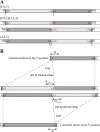A mechanism for a single nucleotide intron shift
- PMID: 28595329
- PMCID: PMC5587772
- DOI: 10.1093/nar/gkx520
A mechanism for a single nucleotide intron shift
Abstract
Spliceosomal introns can occupy nearby rather than identical positions in orthologous genes (intron sliding or shifting). Stwintrons are complex intervening sequences, where an 'internal' intron interrupts one of the sequences essential for splicing, generating after its excision, a newly formed canonical intron defined as 'external'. In one experimentally demonstrated configuration, two alternatively excised internal introns, overlapping by one G, disrupt respectively the donor and the acceptor sequence of an external intron, leading to mRNAs encoding identical proteins. In a gene encoding a DHA1 antiporter in Pezizomycotina, we find a variety of predicted intron configurations interrupting the DNA stretch encoding a conserved peptidic sequence. Some sport a stwintron where the internal intron interrupts the donor of the external intron (experimentally confirmed for Aspergillus nidulans). In others, we found and demonstrate (for Trichoderma reesei) alternative, overlapping internal introns. Discordant canonical introns, one nt apart, are present in yet other species, exactly as predicted by the alternative loss of either of the internal introns at the DNA level from an alternatively spliced stwintron. An evolutionary pathway of 1 nt intron shift, involving an alternatively spliced stwintron intermediate is proposed on the basis of the experimental and genomic data presented.
© The Author(s) 2017. Published by Oxford University Press on behalf of Nucleic Acids Research.
Figures



Similar articles
-
Alternatively spliced, spliceosomal twin introns in Helminthosporium solani.Fungal Genet Biol. 2015 Dec;85:7-13. doi: 10.1016/j.fgb.2015.10.004. Epub 2015 Oct 26. Fungal Genet Biol. 2015. PMID: 26514742
-
A spliceosomal twin intron (stwintron) participates in both exon skipping and evolutionary exon loss.Sci Rep. 2019 Jul 9;9(1):9940. doi: 10.1038/s41598-019-46435-x. Sci Rep. 2019. PMID: 31289343 Free PMC article.
-
Spliceosome twin introns in fungal nuclear transcripts.Fungal Genet Biol. 2013 Aug;57:48-57. doi: 10.1016/j.fgb.2013.06.003. Epub 2013 Jun 19. Fungal Genet Biol. 2013. PMID: 23792080
-
Spliceosomal Introns: Features, Functions, and Evolution.Biochemistry (Mosc). 2020 Jul;85(7):725-734. doi: 10.1134/S0006297920070019. Biochemistry (Mosc). 2020. PMID: 33040717 Review.
-
Coevolution of genomic intron number and splice sites.Trends Genet. 2007 Jul;23(7):321-5. doi: 10.1016/j.tig.2007.04.001. Epub 2007 Apr 18. Trends Genet. 2007. PMID: 17442445 Review.
Cited by
-
Unique and Repeated Stwintrons (Spliceosomal Twin Introns) in the Hypoxylaceae.J Fungi (Basel). 2022 Apr 13;8(4):397. doi: 10.3390/jof8040397. J Fungi (Basel). 2022. PMID: 35448628 Free PMC article.
-
Comprehensive genomic analyses with 115 plastomes from algae to seed plants: structure, gene contents, GC contents, and introns.Genes Genomics. 2020 May;42(5):553-570. doi: 10.1007/s13258-020-00923-x. Epub 2020 Mar 21. Genes Genomics. 2020. PMID: 32200544
-
A functional twintron, 'zombie' twintrons and a hypermobile group II intron invading itself in plant mitochondria.Nucleic Acids Res. 2020 Mar 18;48(5):2661-2675. doi: 10.1093/nar/gkz1194. Nucleic Acids Res. 2020. PMID: 31915815 Free PMC article.
-
Bi-alignments with affine gaps costs.Algorithms Mol Biol. 2022 May 16;17(1):10. doi: 10.1186/s13015-022-00219-7. Algorithms Mol Biol. 2022. PMID: 35578255 Free PMC article.
-
An ascomycete H4 variant with an unknown function.R Soc Open Sci. 2024 Feb 21;11(2):231705. doi: 10.1098/rsos.231705. eCollection 2024 Feb. R Soc Open Sci. 2024. PMID: 38384781 Free PMC article.
References
MeSH terms
Substances
LinkOut - more resources
Full Text Sources
Other Literature Sources
Research Materials

